Sumac, Rhus Juice, Quallah: Good Drink
Sumacs look edible and toxic at the same time, and with good reason: They’re in a family that has plants we eat and plants that can make you ill.
Sumac, poison ivy, Brazilian pepper, cashews, mangoes and pistachios are all related. Poison ivy, of course, is a problem. The Brazilian pepper is on the cusp of toxic/non-toxic. Some people mistakenly call the seeds “pink peppercorns” but true “pink peppercorns” come from a Madagascar relative, not the Brazilian Pepper found in the New World. Cashews have a poisonous shell. Pistachios taste good. Many people are allergic to mango and or the peeling. Often they will also be allergic to other plants in the family as well as sumac or the sap of the sumac. Proceed accordingly.
There are some 250 sumac species in the genus. All the berries of the red sumacs are edible. I know the ones I’ve encountered in Maine and Florida are edible. Acid on hairs on the berries is used to make an ade. The berries themselves can be used to make a spice, sometimes a tea. Sumacs are found throughout the world, with many species in North America. You’ll find them across all of the United States and Canada except for the far north. Sumacs are a shrub or small tree that can reach from four to 35 feet. The leaves are arranged in a spiral and the flowers are dense spikes, an inch to four inches long, on the end of branches called terminal clusters. The fruits are technically drupes and collectively are called “bobs.”
Sumac species tend to be regional. However, one species, Rhus glabra, (Roos GLAY-bra) the “smooth sumac” is found in all contiguous 48 states. The Indians used the shoots of the Rhus glabra in “salads” though many ethonobotanists say the natives never really made “salads” as we know the term. In the northeast the staghorn sumac (Rhus typhina, synonym: Rhus hirta) predominates. It’s the largest of the sumacs and the one with the least tart berries. In Florida the predominant sumac is Rhus copallina, also known the shining sumac, the winged sumac, dwarf sumac, flame leaf sumac and the mountain sumac (curious as there are no mountains in Florida.) The multitude of common names is why botanical names are important. Rhus is what the Greeks called the sumac and it has come to mean red. Copallina (rhymes with Carolina) means gummy or resinous, referring to the sap which turns black when exposed to air and has been used for varnish, particularly in Japan.
Rhus copallina is an attractive bush that turns flaming red in the fall before losing its leaves. Flowers are yellow and green and small, in clusters at the end of branches. Fruits are BB/pea-sized berries with hairs and are covered with malic acid, which is what makes grapes and apples tart. Inside the berry is one seed. You know the berries are ripe with they give a tart taste. (Touch your finger to a berry then your finger to your tongue to test, but not right after a rain, which washes off the malic acid. )
Soaking the unwashed berries in faucet-hot water releases the acid to make a drink, after being filtered twice to get rid of little, irritating hairs (through cloth then a coffee filter or the like.) The Cherokee Indians called the juice Quallah. The seeds of the sumac have tannic acid in them. Putting the berries in boiling will release the tannic acid. It can make a tea but it can quickly become too bitter to drink. To make an ade, use one to two cup of berries per quart of water. I prefer two cups and less water. The “bobs” of berries can be cut off and dried for later use.
Externally cleaned seeds, when ground, add a lemon-like flavor to salads or meat and is used often in Levant cuisine. They make a purple-colored spice, which is very handy where there are no lemons. Native Americans also mixed the leaves and berries of the smooth and staghorn sumac to extend their tobacco. The leaves of many sumacs yield tannin and leather tanned with sumac is flexible, lightweight, and light in color. Oddly, dried sumac wood is fluorescent under long-wave Ultra Violet Light
The fruit of staghorn sumac is one of the most identifiable forming dense conical clusters of small red drupes at the terminal end of the branches. I can remember them growing all over southern Maine and to this day can still go to a stand of them where we used to play. I can remember marveling at their shape. Sumacs flowers from May to July and fruit can ripen from June to September. The fruit often lasts through winter and into spring. While many birds eat sumac berries apparently they are not a preferred fruit in that they are amongst the last to be eaten after a long winter. Deer nibble on the branches, as do people, kind of.
There is another edible part to the sumac: Young shoots, peeled. First year shoots off old stumps are the best, but the spring-time tips of old branches are also edible but not as good. Look at the end of a shoot after you break it off. If you see pith, which is an off-white core, it is too old. Break off that part then look again. You want a shoot stem that is all green inside. Then strip off the leaves and peel the shoot. You can eat it raw or cooked. They very purfume-ish and slightly astringent.
As for other uses of the sumac some landscapers remove all but the top branches to create a “crown” effect making it resemble a small palm tree. All parts of the stag horn sumac, except the roots, can be used as both a natural dye and as a mordant. The seeds have an oil that can be made into candle wax. Even the sap of the poisonous white sumac makes a black varnish.
Yes, there is one poisonous sumac but you probably won’t ever see it and it really doesn’t look like the rest of the sumacs. It resembles an alder, has white berries that grow out of leaf axils and prefers to live deep in swamps, meaning you will have to wade to find it. That might be an exaggeration but it likes to be in wet spots. In my many years of foraging I have seen it in two places. You should avoid it though because it is like poison ivy on steroids. It is the most toxic contact plant in North America. And without going into a long story I did get poison sumac once.
So, to get that straight: The edible sumacs have red berries in cone-shaped clusters at the end of main branches. They have skinny leaves and like dry ground. The poisonous sumac has roundish leaves, pointy on the end, has white fruit that grows out from where a leaf meets the stem, and grows only in very wet places.
Now that you know about the poisonous white sumac, also avoid when looking for sumac the Brazilian Pepper which to the unfamiliar eye can look similar in growth pattern to the regular sumac. The edible sumac has terminal clusters of garnet, purse-shaped berries with a fine coating of fuzz (often gray.) The leaves are skinny, lance shaped. The Brazilian Pepper has long ovalish leaves and clusters of bright pink/red smooth, hairless berries growing off stems.
My video on sumacs is here.
The following three recipes are from fellow foragers Dick Deuerling and Peggy Lantz and their book “Florida’s Incredible Wild Edibles.”
Sumac Jelly: Take prepared juice and use the Sure-Jell recipe for elderberry jelly, 3 cups juice to 4.5 cups of sugar. Leave out the lemon juice.
Sumac Jello: Mix the prepared juice with unflavored gelatin per instruction on package.
Sumac Rubber Candy: Take on cup of sweetened juice, add two envelopes of gelatin, mix. Pour into an 8×8 or 8×10 inch baking pan and refrigerate for an hour or more. Cut and serve. Dick credits that recipe to his wife, long involved with the Girl Scouts as Dick was with the Boy Scouts.
Green Deane’s “Itemized” Plant Profile: Sumac
IDENTIFICATION: Rhus copallina: Shrub, or small tree in Florida, leaves large, divided into 11-23 leaflets, midrib has thin “wings.” Twigs and leafstalks velvety, round, with raised dots. Fruits, red, short and hairy.
TIME OF YEAR: In Florida flowers summer to fall, fruits summer to fall, fruits in fall in northern climes.
ENVIRONMENT: Sunny to shady dry areas, often found on banks.
METHOD OF PREPARATION: Ripe berries soaked in warm water, filtered then sweetened into an ade. Sometimes the ade will be clear, other times light pink. A drop or two of food coloring can make it any color you want. Whole berries can be made into a tea but the hot water can make the tea very bitter very fast so proceed carefully. Peeled shoots, raw or cooked.

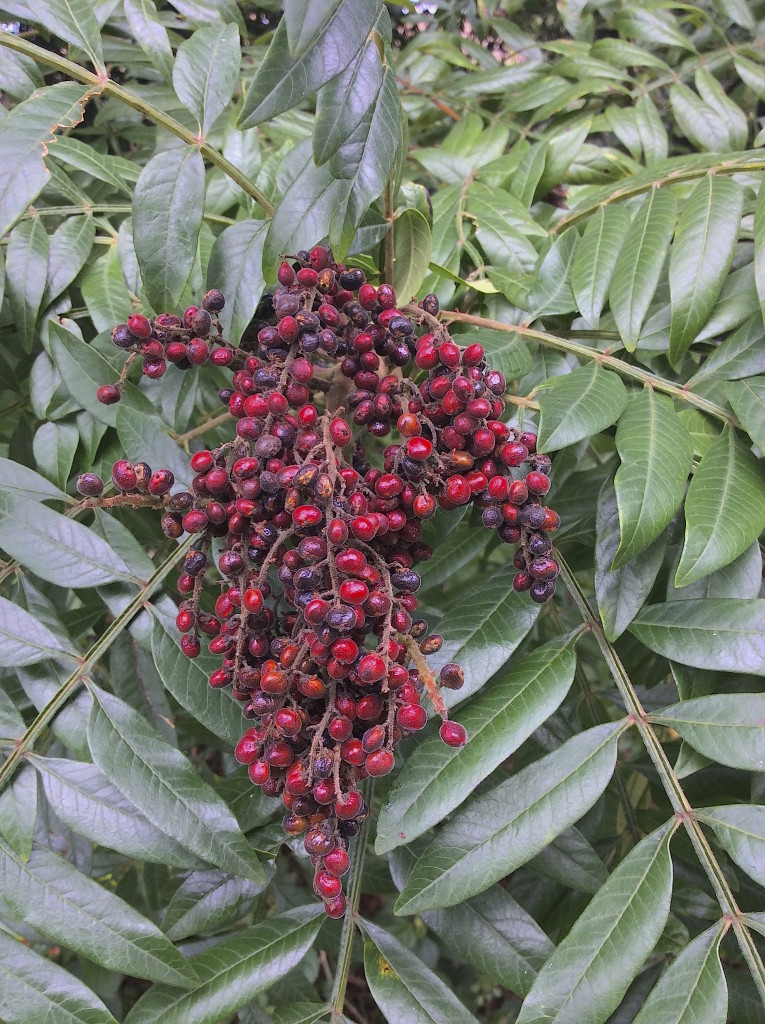
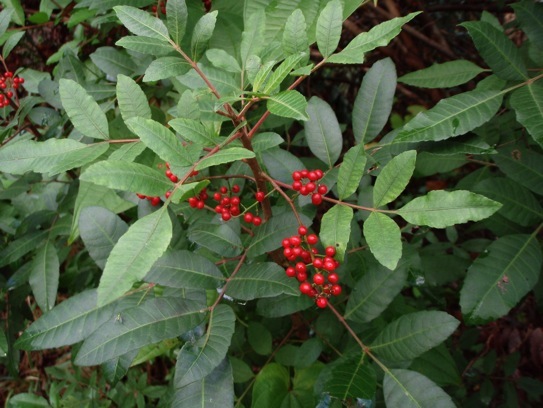
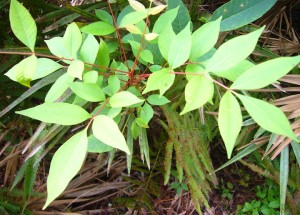
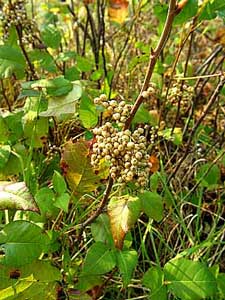
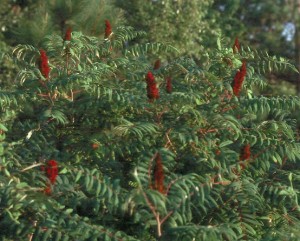
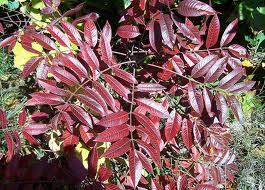
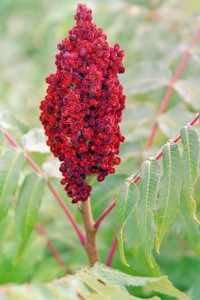
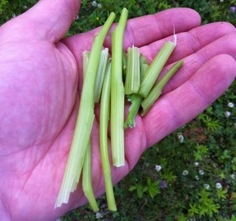
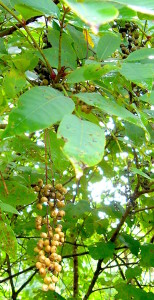

I ran into a couple of French Canadian women who were picking the Brazilian Pepper. They said they ate it. It was very expensive back home and considered a delicacy. I ate some and enjoyed the taste. I now read it may be poisoness.
It did not seem to have any short-term or intermediate-term effects on my health.
Is it really harmful to eat?
Edibility is the question. Those ladies were not eating berries from the same species from which those expensive pink peppercorns are made.
Are those recipes up yet? I’d be very interested as sumac is plentiful here right now.
Hi Deane,
What is the best way to remove the outside flesh of the drupes? I would like to grind them into a spice without the seeds.
Thanks!
Kat
Why? Usually the entire fruit is ground up.
as always-excellent article! Sumac is extremely plentiful here(outside metro atlanta) and i always enjoy a little on the trail!
Thank you yet again for an excellent article
Is there anything one can do with the drupes once they are dried? I picked some this fall from the Staghorn Sumac that are so plentiful here. I wasn’t sure what to do with them or even if they were edible so I just let them dry because they are such a beautiful deep red color.
yes, it’s in the article. The deseeded drupes are ground up into a spice.
Your site is by far the most informative and interesting !……thank you
for all the time you have dedicated to making it so!……you are greatly
Appreciated……I always look forward to your e-mails!
Slainte!
Cynthia
I hope you can help me. I am armenian and a senior citizen. My entire life I’ve known about sumac, but only the dried seeds. My mother would buy it in an armenian grocery store, bring it home and make a dish we call “dolma”. She would boil the seeds in water, then strain it and pour the liquid over the dolma which is small eggplant and grape leaves stuffed with ground lamb and rice, parsley and spices. My mother has passed on, however, I still make this dish. But now I can only get the sumac in a ground form which we do not like. My question is this – do you know where I can buy the whole sumac seeds? I live in Havertown, PA (just outside of Philadelphia. ) Thank you in advance.
Marion
Marion that is a great recipe! Albania has a lot of food I like, spent some time in southern Italy Calabria and there were a few towns Albanian, We really ate well! Wow.. I have fresh sumac and live in Oklahoma I would be glad to send you..You pay shipping and a little for the spice say $10.00 for 1/2 pound.? I’m on Facebook
Interested in buying the red sumac berries as a shaman has to,d me about the ade and drinking it to help with my cancer- now I’m concerned about the allergy part- I understand that most red is ok but reading here someone stated people still had allergic reactions- I’m allergic to poison ivy,oak nd sumac but not mangoes or cashews- would it b safe to try making the ade having taken a Benadryl prior to the tasting of said ade?
The staghorn or smooth sumacs are such common plants that it would be very easy for you to collect more seed than you would be able to use in a year. Dry it and store it as dry whole drupes (berries) and it should keep well in storage for at least 6 months. I’m in Toledo OH, and both types of sumac grow are found in abundance nearly everywhere you look. There are no posion sumacs up here either (or at least none with red fruits). Although I would not recommend eating Rhus Aromatica (a small landscaping plant) its leaves have three rounded lobes unlike edible sumacs which typically have many pointed leaflets.
The best time to collect it is in late july or mid august out here, and you want to try to harvest after a stretch of at least three days of dry sunny weather. I’ve found that placing clear water proof but well ventilated bags over the seed heads after fruit set helps to produce much better quality fruit since it is not exposed to rain or birds. I’ve had lots of trouble trying to clean the seeds though. Can’t figure out how to do this without washing away the flavor.
Marion, if you’re still interested in finding whole sumac seeds, you might try
https://www.mountainroseherbs.com
My late uncle (by marriage) was Armenian. Sure do miss him…
I pick staghorn clusters in fields around where I live. In about 15 minutes you can pick more then you will possible use. I take it home and separate the berries from the stems(which is a pain) and then dry it in my over on the lowest setting for around 5 hours or so. I like to boil the berries lightly and drink that as a tea. I’m sure a few tiny bugs probably get boiled in there too, but if you strain it well you can get the berries, twigs and stuff out of there. I have found it really has an anti-inflammatory effect. I have tendonitis / carpal tunnel and my hands begin to feel better after consuming it.
Marion, here is a store over in Broomall:
Armenian Delight
2591 West Chester Pike, Broomall, PA 19008
The African Sumac (Rhus Lancea) is a very popular landscaping plant, here in the southwest. In fact, we have three in our back yard.
The flowers have a lovely, heady scent. They are followed by tons and tons of white berries, which – unfortunately – sprout all over our landscaping.
I researched it some more on the internet, and found mentions the berries being pounded and fermented into a sort of mead, but have been unable to find any specifics on the matter.
Do you happen to know anything about this process? Perhaps a version using our native sumacs?
Another thought was to use the flowers as people user elderberry flowers (such as a syrup, or fried), as they smell so sweet. But I don’t know if they are edible.
Many thanks!
I have references that say the berries are edible but I personally know nothing about this African native.
Any experience with Rhus trilobata / skunkbush sumac? I found some on a hike in Kansas amongst many staghorn sumac. The berries look a lot like those on staghorn and but is a much lower bush with compound, green leaves with 3 leaflets.
Hi Deane,
I was lucky to attend one of your Orlando foraging days a year or so ago. Good times!
I am reaching out to you as my last resort. I have a few seedlings growing in our garden and they have all the characteristics of staghorn sumac (leaves a bit droopy, reddish stems, the general shape of leaves, etc.)…with the exception of no hairs at all (smooth stem & leaves) and the fact that the leaves are not toothed at all. Not even one little bit.
I cross checked with many a book and web-sites and I came up with nothing that looks exactly the same.
It is not, for sure, Ailanthus altissima (tree of heaven) as it does not have the gland on the leaves nor the foul odor characteristic of this species.
In your experience, is it possible that the seedlings of staghorn sumac may not show hairs nor serrated leaves while under 4 feet?
I also ruled out smooth sumac as the leaves do not look the same, nor does mine have the little “wings” between each leaf characteristic of the winged sumac.
Sorry I wrote this much but I wanted to be sure to give you all the info.
Thanks so much for any insight you might be able to offer.
Pam
Great website!
I have a question regarding the dried Staghorn Sumac: What temperature is the max for preserving the high vitamin C content?
I’ve harvested and want to dehydrate and grind for spice 🙂
Thank you
ej
Under 212F is usually recommended.
I have been soaking my sumac berries in water over night and drinking the water (no filtering) in the morning. The water colour is a soft amber when fresh from the fridge but if left overnight on the bed-side table the ade turns greenish blue, left longer the water turns indigo. What it going on?
Hi,
I love your videos.
But here I feel puzzled.
Because I see elsewhere “Staghorn Sumac” associated to the latin name “Rhus Typhina” and to the images on this page : fruits arranged in bright red and dense conical clusters. And “Rhus Copallina” seems associated to the names “Shining Sumac” / “Winged Sumac” and with images of shiny leaves very different from “Rhus Typhina” leaves.
Can you give some precision ?
Thanks.
With apologies, I don’t understand the question. Sumac species leaves do vary. The Winged Sumac have little “wings” on the stem that other sumacs don’t have.
This year, for the first time, all of the Rhus Glabra and staghorn sumac bushes/trees around here have berries that are mostly BROWN (only a few red berries in each cluster) and drooping rather than upright on the plants. Our area has had unprecedented copious rainfall this year; I picked some berries and tasted them and they taste sour as usual even though brown; are they still good?
Yes, if they are still tart they have the acid you can use.
The sumac color is so beautiful, Iwould like to dry some. Is therea good way to do this to keep the color?
Food coloring.
My berries all retained a nice pink color by drying slowly in an oven set around 150 degrees. I’ve had them now for about a month and a half.
I’ve been enjoying the sumac lemonade for a few years and I always wondered if it was possible to make jelly from it. That’s when I found your blog and I tried it. The jelly was delicious! Thank you for the info! I’m thinking about planting a staghorn sumac tree or two in my backyard.
Where can I find in central fl sumac.
Just about everywheres… dry places under pines, flatwood scrubs and the like.
I have just been made aware of using sumac for lemonade and am so excited! It is pretty late in the season here, but I did harvest some of the seed heads. They are quite dry (most of the plants’ leaves have fallen), have a bit of red color left. Are they still ok to use for sumac lemonade? Is the ideal time to pick them when the leaves are still green?
As long as the seeds are tart they can be used.
Having read a bit about this plant, I have to make one exception: On the [banned site] page (and yes, I know you can’t necessarily trust everything there), it says Sumac is not necessarily the best source of food for birds and is the last plant they will seek.
That has not been my experience. On our southwestern Virginia mountain top, a large bush of Staghorn Sumac grows right outside our house. I have seen it repeatedly covered with birds nibbling its “berries”, including a flock of 30 or so robins. A Northern Flicker, Titmice, Grosbeaks and all sorts of other birds have also used it as food all winter long. It is such an effective food source that when we perform some reconstruction near our home, I hope to dig it up and re-plant the bush so I can continue to enjoy watching the birds all winter long.
bonjour j ai une question j ai planter du fort longtemps un sumac espèce virginie c est a dire qu a la floraison apparent des épies de couleur rouge par contre je suis obliger de le surveiller car il est très envahissant ma question est t il comestible car dans mon île de corse il y a n a beaucoup mais planter comme arbre d ornement merci de bien vouloir me renseigner
J’aurais besoin d’un nom botanique.
Found a huge grove of these smooth sumac here in Oklahoma close to where I work alongside a railroad track. I’ve been harvesting the straightest saplings to use in a wattle fence I’m building.
Everyone should be aware that railroad tracks are some of the most polluted places in America, so you probably don’t want to eat anything growing along railroad tracks. Fencing should be fine.
Hi ! I just found your website because I was trying to find pictures of the staghorn sumac, and the other one that is like staghorn sumac except the berries hang down,so I could send it to my friend who has a sore throat. I used to have a book called ,”Eat the Weeds” back in the seventies. Was that you, Dean? I don’t know where it is right now to look, but that book kept my first husband and me alive in the summer of 1973. He was in college on the VA plan, there were NO jobs where we lived and we had no income all summer. We ate the wild plants in that book along with small mouth bass and a woodchuck, a muskrat which was too tough to even bite, a porcupine, which was really delicious, and some roadkill deer meat. I had the best shape I ever had in my life and we were healthy. I learned from that book that the sumac berries are good to make a tea that gets rid of sore throats. It is the best sore throat medicine I ever used. I have been using it now for forty-two years and it works fast. One cup can get rid of laryngitis enough that you will be able to talk right after drinking it. Love your site, I intend to explore it! Thank you. Jill
I think the author of that book died about 20 years ago but it is still in print here and there.
Take on cup of sweetened juice, add two envelopes of gelatin, mix. Pour into an 8×8 or 8×10 inch baking pan and refrigerate for an
Thank you for your interesting comments and info,I live in NH and
I have many of these wild sumacs growing in my yard and even off the sides of roads.I would like to make tea or this aid people talk about,
as long as its safe.These sumacs I have growing in my yard are also
apparently growing near wild berries that iv’e eaten and wild grapes.
My only mistake was I got rid of alot of wild berries before I new how
good they were to eat, also remove wild elderberries from my wooded
areas but to my suprise they are all growing back with wild blueberries.
I am happy to have these plants around me. Comments Please
Hi Deane!
Noticed in your video (#43) on sumac that you mentioned malic acid as what makes sumac sour, and then later on in your narrative, switched to ascorbic acid. I suspect that there are several organic acids involved. Would appreciate any links to research studies you might be able to find that show the acids in the sumacs of North America. A lot of people claim that sumac is rich in Vitamin C, but I have yet to see consistent proof of that assertion from laboratory analysis.
Ascorbic acid IS vitamin C
Yes, but… this does not explain the shift from referring to the acid on the drupes first as malic acid and then. later in the article. as ascorbic acid, as Mike points out.
Is it safe to eat the seeds on the clusters of stag horn sumac? I’ve got dozens of bush trees across the street and they make me hungry XD. If I can eat them, please let me know, thanks 🙂
Well…. they are used to make an ade or dried and ground to make a spice. One does not usually eat them anymore than one eats a pepper corn.
Be aware of the hairs, they could make your throat feel weird and make you cough.
Alright, just needed to know. It is dissapointing though as the drupes stay on the plant through the winter and they are the only sign of organic tastiness where I live while it snows.
When we were kids in CT, we were under the mistaken impression that this was “poison sumac” and tried to avoid it in the lots and woods that surrounded us. As a young adult, the first time I heard about making an ade from the “poison” berries, I was blown away! LOL!
I hope someone can help me with a plant ID, though I doubt it is at all edible it is ridiculously common. It is a tree that was prevalent in the city, it sprung up in any crack or crevice with soil. (CT) Tenacious and very fast growing, with a leaf structure very similar to sumac, except, if I remember correctly, it had winged seeds similar to maples, nothing like the heads common to sumacs. (Then again, it was a long time ago and I could just be misremembering!) We now live in FL but used to vacation here, and I always LOVED the palm trees. We had a cluster of the mystery trees growing in back of our house and I called them our “CT palms” because of their superficial resemblance. They were so plentiful I know someone can tell me what they are! I would love to finally know! Thanks in advance!
Ha I finally found it by accident, it’s called “tree of heaven”! Ailanthus altissima.
No ailanthis is a poisonous plant that looks similar but has branches longer than 12 inches and a little easily identifiable “nodule” like gland near the stem of the leaves
I forgot to say…it was “A Tree [that] Grows in Brooklyn”!
Love your newsletters they inform and keep me focused! I have a big question about the sumacs. Last year after signing up for your newsletter I collected and made sumac lemonade. My husband keeps bugging me for more. Now being July I wanted to collect more. How can I collect and store long term?? Mostly I guessing for sumac-ade. Bring them inside for awhile to prevent mold??
Ps I would love a seasonal list of the things I can forage for. Thanks so much I have ur DVDs on my honey want me list!! Hopefully soon!! Kristyne
Bring the ripe terminal clusters inside and dry an a dark moderately cool place. They will last until next season.
There is so much info about the sumac berries but I want to know about the flowers. Can one safely make a tea with the flowers? Are there any medicinal qualities?
I just tried some sumac jelly! I like my jam a little softer than recipes generally make, so I used 3.25 cups of sumac tea (steeped four times with different spears each time, and heated up in the microwave in the middle) 2 cups brown sugar, 2.5 cups white sugar, and Certo crystal pectin. It’s got a nice soft gel on it, it tastes like a delicate apple jelly, and the colour is simply delightful – like a deep amber honey.
Thank you so much for this post! It helped a lot with this experiment. This was my third batch of found-ingredient jam this year, and they’ve all been a success. (Dandelion jelly, Mostly Blackberry jam from the ravine near our house, and now Sumac Jelly.)
I’m having an issue identifying this thorny shrub. The drupes look like part of the Rhus species, but I don’t see any with thorns, or the rounded (ovate, pinnately compound leaves) . I mowed over a few of these the other day with the brush hog, and it smelled great, very sweet and fruit-like, but don’t look like the normal Aromatic Sumac.
Link to picture: [img]http://i.imgur.com/0yyUY9A.jpg[/img]
The image is less than 1/2 and inch by an inch. I can’t see it well enough to even guess.
The answer to Bob’s question is prickly ash, Xanthoxylum americanum. It’s used medicinally, and has a citrus-like odor. One of its uses was to numb the mouth for tooth extraction. That led to its common name, “Toothache tree.”
Hello there ~
Forgive me if this was covered in the comments. I did scan but didn’t see. Are you familiar with any uses for the sumac leaves? Are they edible / tea- able?
Thanks!
Su
That question comes up now and then and as far as I know the answer is no. However I did see someone eat a leaf once and nothing came of it.
Green Deane- I love your website & videos! I happened across Sumac starting on page 280 in the Peterson Field Guide Eastern/Central Medicinal Plants and Herbs.
Native Americans made tea with the leaves for asthma
Smokable in traditional tobacco mixes. Not aware of use in tea.
You can smoke them. They’re good in a pipe or rolled into cigarettes. Traditionally the Iroquois and other southern Ontario tribesmen would smoke this mixed with tobacco or just plain without tobacco. I pick it in the fall when the leaves first turn red and hang clusters of the compound leaves upside-down until dry. Then, I run my fingers along the stems (rachis) and remove the leaflets and crumble them into an airtight container for storage in the freezer. I know of no other uses for the leaves, but will vouch for their suitableness for an occasional smoke. It is smooth and seems to be without ill effect when taken in moderation once in a while.
An infusion of the leaves is used for asthma, diarrhea and stomatosis. A poultice of the leaves used to treat skin rashes. Sumac leaves are also chewed for sore gums and rubbed on sore lips.
Do you know when leaves are at their best for asthma, green, yellow, orange, red or maroon?
I picked some stag horn sumac berries boiled it with some elderberries, wild black cherries, and a few mint leaves. boiled it down and strained out the pulp and pits. added sugar and it made a tart drink similar to cranberries. it would give the mouth a dry feeling. then I mixed jaquinns ginger flaver brandy and it tasted just like a blueberry pie. some friends of mine couldn’t get enough of it. It was verry tasty.
Oh wow. Love the thought of this…
I hope you can help me, I was wondering how do you remove the pulp from the seeds? I want to make it into a Spice rub and don’t know how to seperate the pulp from the seed. I was told you can’t eat the little seed, just the pulp around it. Is that true or do you grind the whole Sphere and use it?
One the fruit is dried it is all ground up. Outside pulp and seed inside.
Connie, when I lived in Ann Arbor, MI, I was able to buy zaatar at Detroit’s Eastern Market. It is a Middle Eastern spice that contains sumac. Tried it on flat breads and as a rub on chicken, but I found it bitter. Being a science teacher, I was able to examine it under a stereomicroscope. As Green Deane said, the dried drupes were ground up, coating and shell and seed together. The mouthfeel was unpleasant due to the thin, but hard shells surrounding the seed, and the seeds must have tannin in them to make them very bitter.
There is a very simple way to make a non-bitter rub: pick the drupes off the fruit head, and rub them against the wire mesh of a kitchen strainer into a bowl below. You’ll need to scrape off the oily residue of the sour drupe coat that comes through and clings to the underside of the screen. You can store this at room temperature in an empty spice bottle. It makes a wonderful spice rub.
In our neighborhood (La Crosse Wisconsin) we have both staghorn and smooth sumacs, (R. typhina and R. glabra) wild and introduced into landscaping. Later in the year or up to a week or two after a rain, the seed heads can be bitter or just bland and oil-less. But when there has been a week or two between rains in warm weather, sumac fruits are oily and tart, not bitter. So perhaps you can improve the taste by timing the foraging. It isn’t easy, sometimes you have to get out there if you know a rain is coming.
It’s easy. Just throw the clusters in the blender for a few seconds, that will separate the seeds from the stem and the pulp from the seeds. Then push it thru a strainer. After I strain it, I like to put it in a coffee grinder, it will produce a fine powder, perfect for cooking!!
Hi! I saw your post about sumac and would love your ideas for making the sumac ade!
Thank you!
Sarah
Hi Deene,
I was scanning through the comments and questions about how to remove the drupe from the seed in order to have the “spice”. Last fall my friends and I gathered POUNDS of heads and thus “cleaned” drupe from stems. After totally drying I ran the drupes through a blender to knock the skin off the seed. This does an excellent job and then it’s ready to use in ade or as a spice. I will also be using this to make candy for Christmas; both gummy and hard candy. I currently have a family sized ice cream tub full of the powder waiting. Wish me luck!
Cyndi B., Ozark, AR
Hi there, I am an Arborist of 25 Years and living in New Zealand. I am identifying a whole bunch of trees at a garden that I have worked at and I have come across a Rhus species and have done considerable research in trying to find this tree. I think it is Rhus typhina, but the bark is a gold/yellow colour and peeling, it is more upright than the (suckering typhina) tree that I know. Also on the leaf stalk (Rachis) there are pairs of very small leaves at the base of the leaflets. I do have pictures of the above but will wait to see if you are still using this site.
Hope you can help.
Clive
I’m still running this site but I would think you would be the better expert on Rhus in your area than I can be.
Sounds like Winged Sumac/Shining Sumac. The little leaves you mention are the ‘wings’.
Planting wild fruits like the staghorn sumac give you more than the tasty fruuit etc.They look beautiful and once established are easy to grow.I’m glad that the guy who unknowingly cut down his blueberry and elderberry plants is getting a second chance and that he like me appreciates wild grapes.These things are not hard to grow and very few shrubs are as pretty as blueberries.Year round they look great.More of our native plants should be used in edible landscapes.
Tried eating the shoots and they taste spicy…you said perfumy and I get that but I’d say it’s so strong it’s spicy! Is that right or did I get the wrong plant?
Thank you sooooo much for this great site and wonderful article! And all the contributory comments. It’s been a great help to finally know so much about a tree I inherited when I bought my house 14 years ago, and had thought it was a nuisance. You see, the tree has only this year produced flower/seed heads; and appears to be an extension from the neighbouring property’s tree plant. It has a tendency of transplanting quickly and through its underground roots. So we thought it was a nuisance but pretty. We kept it, as it reminded me of a similar looking tree of my childhood in Africa. Now thanks to your site and the great comments herein, I will treat my sumac tree with greater respect and affection -for the blessings that it brings me. Merci
Pulverizing the drupes is my inevitable outcome when attempting to process sumac for cooking purposes. Videos and instructions found online make reference to the seeds being too hard for a grinder or blender to penetrate – ha! Mike – I am interested in your findings – I hope you share your pdf’s, even after all these years!
Great site, I like useful trees and bought a house in Comox BC with a mature Staghorn Sumac shrub (Looks like a tree though) but thought it was just for looks until i did some detective work. Needless to say Im pleased enough to let the clonal roots spread around to make more a bit farther away from the house. It has the tropical look that I like as well. It should be quite a sight another 20 years!
I have been harvesting native sumac in the southeast for a few years, I noticed this year that some of the drupes looked grey. At first, I thought it was mold, but I looked with a 10x loupe and I don’t see any mold. The surface looks the same as the rest of the drupe just a different color. These drupes are not uniformly that color but usually just half the drupe. Are they maybe not quite ripe? Thank you
I have recently joined a micro green group, that grows sprouts n such for food, could or is the staghorn sumac baby plants edible? Since I collected the tops and made lemonade, and already have tons of crushed seeds for a spice, o thought perhaps the young greens maybe 2-3 inches tall might be edible?
I have Sumac on my land, but the ‘berries/drupes’ are red. Is it still safe?
i really wanted to share your site with my best friend, and others on my f.b. page… my buddy has silver colored sumac on his prop. another buddy say it is safe to eat and make pies and stuff..in the back of my mind, i recalled you said white one are the bad ones.. i told him don’t eat any till we are all squared away…if ya tell me how to share your site, i will..can’t wait to dive deeper in the archives…i am a throwback from years gone by, i understand the so called food we buy at store is not as healthy as what we gather in the bush..the smarter us humans get on computers, the dumber we get in the woods or even our own backyards..keep up yer great endeavors.
Copy the below url and paste it on your Facebook page. Hope that help.
https://www.eattheweeds.com/sumac-more-than-just-native-lemonade/
I live in Washington state. It appears “Smooth Sumac” (Rhus glabra) is the native edible sumac here. What I read and saw in the video mentions “hairs” which, of course, “smooth” sumac doesn’t have. Are the drupes still useful? Can I still make ade or grind as a spice? Or make wine? 🙂 Thank you for any information you may have! Kati
Kati, smooth sumac makes an excellent sumac lemonade. I have instructions on a pdf that I can email you if you will send me your email. My email address is mikekrebill@aol.com.
Do you think I can find it in Vancouver, Canada area?
I might find it online, but I prefer it freshly picked 😁
Dear Mr. Deane,
Thank you for years of enlightenment into the world of Green.
Today, I turned to you for info on the Winged Sumac,
and found another treasure chest.
My question:
Since the rain washes off that very taste we are seeking,
why do I cut the drupe from the bush?
I don’t need the seed, so I propose….
Using a large mouth jar containing warm water,
simply dip the drupe into it and rinse the
flavor into our jar, and release the drupe into
the wild to “rejuice” itself, for another day.
Seems like we could get a LOT more SumacAde.
Thanks again.
Mr. Brown
Alachua county, Florida.
10/10/2020